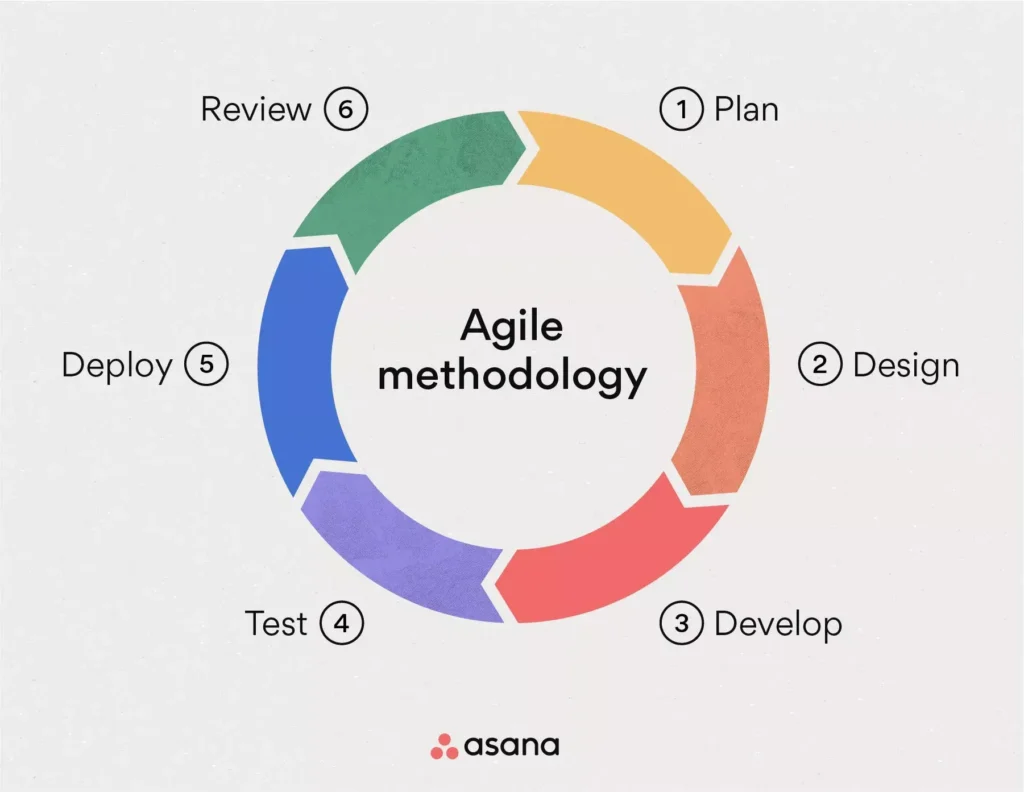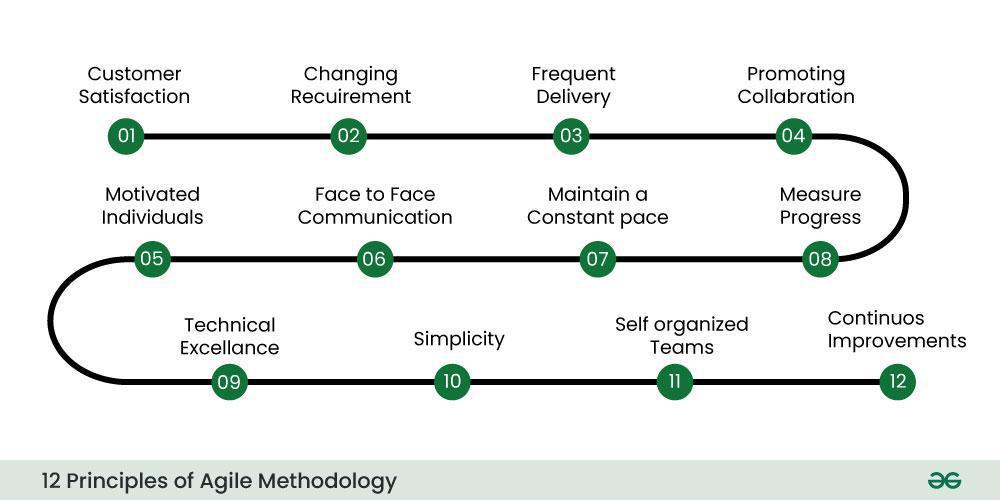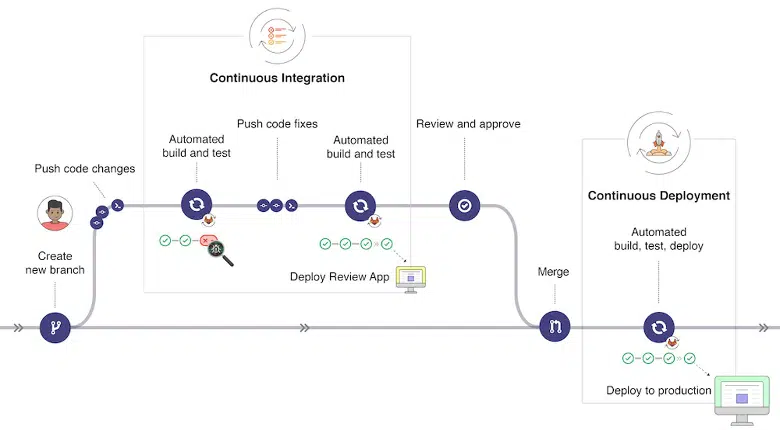Agile methodologies have fundamentally transformed team workflows in software development. Agile prioritizes flexibility, collaboration, and customer satisfaction, focusing on delivering functional software in short, iterative cycles.
A pivotal component of Agile development is test automation. Test automation employs software tools to execute repeatable tests against a system. These automated tests quickly verify system behavior, providing rapid feedback to the development team. This capability is particularly crucial in Agile projects, where changes are frequent, and speed is paramount.
The significance of test automation in Agile projects cannot be overstated. It underpins Agile principles such as rapid delivery, continuous integration, and frequent releases, ensuring high software quality and accelerating the feedback loop. Test automation enables Agile teams to maintain development velocity without compromising quality.
Test Automation in Agile Methodology: The Complete Guide

Figure 1: Agile framework (Laoyan, 2024)
This blog post explores effective strategies for implementing test automation within Agile frameworks. Key strategies will be examined, including selecting appropriate automation tools and the importance of continuous testing.
The objective is to offer insights to help Agile teams optimize their test automation efforts and achieve project goals more efficiently and effectively.
Agile Methodology and Its Key Principles
Agile methodology is a project management framework that divides projects into several dynamic phases, commonly known as sprints. This approach emphasizes flexibility, collaboration, and customer satisfaction, focusing on delivering functional software in short, iterative cycles.
The Agile Manifesto outlines twelve key principles that guide Agile projects.

Figure 2: Agile Methodology (GeeksforGeeks, 2019)
Role and Benefits of Test Automation in Agile Projects
Test automation plays a crucial role in Agile projects. It involves using software tools to run repeatable tests against a system and providing rapid feedback to the development team (Kale, 2024).
This practice supports Agile principles of fast delivery, continuous integration, and frequent releases, ensuring high software quality and accelerating the feedback loop.
The benefits of test automation in Agile include:
- Rapid Feedback: Immediate identification of defects allows for quicker resolution.
- Consistency: Automated tests ensure continuous validation of all code changes, maintaining consistent software quality.
- Efficiency: Reduces manual testing effort, allowing testers to focus on more complex test scenarios and exploratory testing.
Challenges of Integrating Test Automation in Agile Environments
Despite its benefits, integrating test automation in Agile environments presents several challenges (Prometteur solutions, 2023):
- Time: Setting up a test environment can be a bottleneck.
- Resource Intensive: Automation testing can require significant resources.
- Data Reliance: There can be a lack of comprehensive test data for automation testing.
- High Initial Investment: Automation testing requires a significant initial investment.
- Inadequate Testing Infrastructure: Problems with the testing infrastructure can impede automation efforts.
Despite these challenges, the benefits of test automation in Agile projects far outweigh the difficulties, making it a crucial component of Agile methodologies.
Key Strategies for Effective Test Automation in Agile
Start Early in the Development Cycle
Integrating test automation early in the development cycle is crucial for proactive issue resolution. This approach is particularly important in Agile projects, as it prevents the accumulation of technical debt and ensures a higher quality product (Joseph, 2024).
By initiating automation testing in the early stages, teams can detect and address bugs promptly, enhancing the overall quality of the software.
Maintain a Robust Test Automation Framework
A test automation framework is a set of guidelines designed to produce beneficial results from automated testing activities. A robust framework should be fast, efficient, reusable, and capable of delivering comprehensive bug reports. It should support multiple operating systems, offer extensive integration capabilities with CI/CD tools, include robust reporting features, and be user-friendly and cost-effective (PractiTest Team, 2024).
Maintaining such a framework involves adhering to best practices such as early integration, careful tool selection, scalability, data-driven testing, collaboration, continuous testing, and continuous learning.
Prioritize Tests Based on Risk and Impact
Identifying critical features requiring rigorous testing is pivotal for prioritizing strategic test cases (Ceelen, 2024). Techniques for prioritizing test cases include coverage-based prioritization, ensuring that the code’s most critical parts are tested first.
Other factors to consider when prioritizing test cases include repetitiveness, risk, complexity, and stability. This approach thoroughly validates the software’s most important and vulnerable aspects.
Continuous Integration and Continuous Testing

Figure 3: Agile DevOps Pipeline (Dobra, 2023)
Continuous Integration (CI) in Agile enables developers to automatically merge all code changes into a shared repository several times daily. Continuous Testing (CT) ensures quality by providing continuous feedback through automated testing throughout the development cycle.
The benefits of CI and CT in Agile projects include improved code quality, reduced risk, a fast, reliable, and sustainable development pace, and high software quality assurance. These practices are integral to maintaining Agile methodologies’ iterative and incremental nature.
Collaborate and Communicate Effectively
Effective communication is crucial for managing stakeholders in Agile projects. It ensures everyone understands the project’s progress, challenges, and changes. Tools like issue-tracking software, team collaboration applications, and development and planning tools can facilitate seamless and meaningful information flow (LeanWisdom, 2023).
By informing stakeholders through transparent and frequent communication, Agile teams can build trust and maintain alignment with project goals. This collaboration fosters a cohesive environment where all team members are aligned with the project’s objectives and can contribute effectively.
Leveraging Tools and Technologies
Overview of Popular Tools and Technologies for Test Automation
Numerous tools and technologies are available for test automation, each offering unique strengths and capabilities. Below is an overview of some popular options:

Figure 4: Six basic steps in creating a Selenium script for test automation (Homann, 2019)
- Selenium: An open-source tool for automating web browsers, supporting multiple programming languages, browsers, and platforms. While Selenium is powerful, it requires significant setup and programming knowledge, which can be a barrier for teams new to automation.

Figure 5: Appium 2.0 Architecture (Mason, 2023)
- Appium: An open-source tool designed for automating mobile, web, and hybrid applications on iOS, Android, and Windows platforms. Although Appium is robust, it can be complex to set up and use, particularly for intricate mobile applications.

Figure 6: Jenkins seamlessly automation test process (Mumcu, 2024)
- Jenkins: An open-source automation server that enables developers to build, test, and deploy software. Jenkins is highly customizable and integrates with many tools, but its complexity can be challenging to set up and manage.
Choosing the Right Tools for Specific Project Needs
Selecting the appropriate test automation tool is crucial for the success of automation efforts (Felice, 2024).
- Project Requirements: Understand the project’s specific needs. For instance, Selenium might be suitable for testing web applications, but more sophisticated tools might be necessary for complex workflows or business logic applications.
- Supported Platforms: Ensure the tool supports the operating systems (e.g., Windows, Linux, macOS, Android, iOS) where the application will run. However, support for a platform does not guarantee flawless operation on that platform.
- Ease of Use: Consider the tool’s learning curve. Tools with user-friendly interfaces and comprehensive documentation can help teams get up to speed quickly. However, more user-friendly tools may lack the power and flexibility of those requiring greater technical expertise.
- Integration Capabilities: The tool should be capable of integrating with other tools within the CI/CD pipeline to ensure seamless workflow and efficiency.
Case studies
Real-World Examples of Successful Test Automation in Agile Projects
- Large E-commerce Platform: This company experienced significant quality issues due to reliance on manual testing, leading to customer attrition. The implementation of test automation resulted in a marked improvement in product quality, established a 10-minute feedback loop, and significantly reduced the development cycle.
- DHL: The enterprise logistics services company utilized test automation for their shipping labeling tool, achieving a 65% faster run time, increased test coverage, and a substantial rise in the number of tests conducted.
- GoFundMe: The crowdfunding platform struggled with slow test runs and high test failure rates. After adopting test automation, they experienced test runs that were 30 times faster, a 98-99% reduction in test failures, and a 50% increase in the number of developers writing tests.
- Siemens Software: The CAD/CAM/CAE/PLM software company dealt with extensive, flaky, and slow codes, as well as numerous false negatives. Implementation of test automation led to a 49% reduction in test code, a 38% increase in productivity, a 375% increase in test execution speed, and savings of over 290 person-hours per quarter.
Lessons Learned from These Case Studies
- Quality Improvement: Test automation significantly enhances product quality by reducing the errors associated with manual testing.
- Increased Coverage: Automated testing increases test coverage, ensuring a more comprehensive assessment of features and functionalities.
- Faster Feedback: Automation provides faster feedback, enabling teams to identify and resolve issues more swiftly.
- Time and Resource Efficiency: Test automation conserves significant time and resources, boosting overall productivity.
- Reduced Failures: Automation considerably lowers test failures, ensuring more reliable software delivery.
These case studies underscore the value of test automation in Agile projects, demonstrating tangible benefits and improvements across various domains. The success of test automation is contingent upon the selection of appropriate tools, the design of an effective automation strategy, and alignment with project objectives.
Summary
In conclusion, the integration of test automation within Agile frameworks is not merely a technological shift but a strategic imperative that enhances software quality and team efficiency.
By understanding Agile principles and the transformative role of test automation, teams can leverage these strategies to adapt quickly to changes, mitigate risks, and deliver superior products that align with customer needs. The effective application of test automation—beginning early in the development cycle, maintaining robust frameworks, prioritizing tests based on risk, and ensuring continuous integration and testing—empowers Agile teams to maintain high velocity and precision in software development.
Furthermore, effective collaboration and the strategic use of tools amplify these benefits, enabling teams to meet and exceed the dynamic demands of modern software projects.
This blog post has elucidated strategies that not only facilitate the integration of test automation but also maximize its impact, helping Agile teams achieve greater productivity and project success.
Talk to SmartDev
At SmartDev, we are committed to harnessing the power of Agile methodologies and test automation to enhance our software development processes. By integrating effective test automation strategies early in the development cycle and maintaining robust frameworks, we ensure that our solutions meet the highest standards of quality and performance. We invite businesses, innovators, and technology enthusiasts to collaborate with us and discover how our expertise in Agile and test automation can drive significant improvements in speed, efficiency, and product quality.
Let’s work together to leverage these cutting-edge practices in Agile projects, creating solutions that are not only innovative but also highly reliable and scalable.
Contact SmartDev today to explore how we can help you achieve your strategic goals with the power of Agile and test automation. Together, we will advance the capabilities of digital software development and set new benchmarks in the industry.







